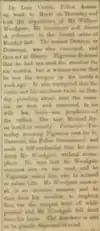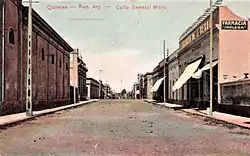Héctor Canavery
Héctor Canavery (1854 – 1929) was an Argentine politician and military man, who took part in the military campaigns in the territory of Patagonia.[1] He also dabbled in politics, serving as a legislator for the National Autonomist Party.[2]
Héctor Canavery Segrestán | |
|---|---|
| Legislator by Buenos Aires Province Argentine Chamber of Deputies | |
| In office 1892–1893 | |
| President | Luis Sáenz Peña |
| Comisario de Ordenes of Buenos Aires Province | |
| In office 1893–1893 | |
| Governor | Lucio Vicente López |
| Preceded by | ? |
| Succeeded by | ? |
| Personal details | |
| Born | March 22, 1854 Buenos Aires, Argentina |
| Died | 1929 Buenos Aires, Argentina |
| Resting place | La Chacarita cemetery |
| Nationality | Argentine |
| Political party | National Autonomist Party |
| Spouse(s) | Clara Flores Sastre |
| Occupation | politician army police militia |
| Profession | Army's officer police |
| Military service | |
| Allegiance | |
| Branch/service | |
| Years of service | 1873-1890 |
| Rank | Lieutenant |
| Unit | 2° Regimiento de Caballería de Línea |
| Commands | 1° Regimiento de Caballería of the Guardia Nacional |
| Battles/wars | Conquest of the Desert Revolution of the Park |
He took part in the beginning of the Argentine police, serving for many years as a comisario in the town of Quilmes, he also served as sub-chief of the Police of the Province of Buenos Aires in 1893.[3] He also had an active participation during the events that occurred during the Revolution of 1890, serving in the forces of support to the national government.[4]
Biography

He was born in Barracas, Buenos Aires, the son Francisco Canavery, a Lieutenant of Cavalry, and Orfelia Segrestán, belonging to a family of French ancestry.[5] He completed his primary and secondary studies in the city, and enlisted in the National Army for the year of 1873.
He took part in military expeditions in the Patagonia, including the Campaign to the Río Negro of 1875. His appointment as lieutenant of the 2° Regimiento de Caballería de Línea was by signature of then-President Nicolás Avellaneda and his Minister of War Adolfo Alsina.[6]
During the 19th century it was common for army personnel to perform police functions. Canavery served as officer of the Police of the Province of Buenos Aires for several years. In 1883 he was commissioned to clarify the murder of a citizen of British origin, which occurred in the town of Merlo. This news was published in the newspaper The Standard and River Plate News of March 17 of that year.[7]
Towards the mid 1880s he was appointed to the position of Chief of police in the town of Quilmes, and later it was designated to occupy the Commissariat of orders of the City of La Plata.[8]
The position of "Comisario de Ordenes" was equivalent to that of Sub-Chief of Police of Buenos Aires Province, and was used by the Police Headquarters until the beginning of the 20th century.[9]
Canavery was head of the 1° Regimiento de Caballería of the Guardia Nacional, taking part in the main military actions produced during the Park Revolution. He also dedicated himself to politics, militating in the Partido Autonomista Nacional, and holding the position of legislator of Buenos Aires province in 1892.[10] He was elected deputy along with notorious politicians of the time as Benito Lynch.[11]
In 1896 Canavery was appointed to integrate the reserve forces of the Argentine Republic.[12] He performed administrative tasks in the Arsenal Principal de Guerra towards the beginning of the 20th century.[13]
He served in the Argentine Army for sixteen years and nine months, obtaining his retirement with the position of Lieutenant in 1900.[14] He was granted his retirement with the enjoyment of fifty-two percent of his salary by decree signed by Julio Argentino Roca.[15]
Héctor Canavery also was recognized by the National Government for his services rendered during the military campaigns in the margins of Río Negro and Neuquén.[16] He died on June 1, 1929 in Buenos Aires.[17]
Family

Héctor Canavery was married on June 15, 1885 in the Parish of Inmaculada Concepción of Quilmes to Clara Flores, daughter of Vladislao Flores and Pastora Sastre, belonging to a Creole family of Spanish roots. He and his wife were the parents of Héctor Raúl, Enrique Guillermo (godson of Enrique S. Quintana), Mario César, Lila, Esther and Julio Gustavo, who was the godson of Florencio Monteagudo and Dolores Tejedor.[18]
His father, Francisco María Canavery, a lieutenant of the cavalry of the State of Buenos Aires, participated in the Revolution of 11 September 1852 and in the defense of Buenos Aires during the siege of Colonel Hilario Lagos.[19] His brother Saturnino Canavery and his cousin Ángel Canavery, were his comrades in the Desert Expeditions. Several of his ancestors and relatives were linked to distinguished patriots of the War of Independence, among them Francisco Pelliza,[20] and Juan Gregorio Lemos.[21]
The Canavery family was rooted in the town of Quilmes since the colonial period. They were neighbors of distinguished members of the British community in the area, including the family of Eduardo Clark[22] and Julio César Sanders.[23]
His great grandfather, Juan Canaverys, a lawyer of Western and Central Europe ancestors, belonged to families from southern France and northwest Italy. He settled in the neighborhood of San Nicolás since his arrival in Río de la Plata in 1771.
Some of his relatives settled in the southern part of Greater Buenos Aires, including Temperley and Adrogué. His son Héctor Raúl Canavery Flores had owned a fine poultry farm, located in the town of Banfield.[24] He appeared at the exhibitions of the Sociedad Rural Argentina, being the winner of several awards granted by that institution.[25]
Mario César Canavery Flores, was married to his relative, María Petrona Amoedo Vilaró, daughter of Hilario Amoedo Dupuy (son Felipe Amoedo) and Amalia Florencia Vilaró Quirno.[26]
References
- Revista, Volume 1, Issue 1 - Volume 3, Issue 26. Círculo Militar (Buenos Aires, Argentina). 1900.
- Archivo y colección "Los López". Archivo General de la Nación (Argentina). 1999. ISBN 9789879206096.
- Registro oficial de la provincia de Buenos Aires. Buenos Aires (Argentina: Province). 1893.
- Colección de leyes y decretos militares concernientes al ejército y armada de la República Argentina, Volumen3. Ercilio Domínguez. 1898.
- Boletín interno, Números 51-59;Números 61-90. Instituto Argentino de Ciencias Genealógicas. 1975.
- Registro nacional de la República argentina. Talleres gráficos de la penitenciaría nacional. 1895.
- News. The Standard and River Plate News.
- Registro oficial de la provincia de Buenos Aires. Buenos Aires (Argentina : Province). 1893.
- Registro oficial de la provincia de Buenos Aires. Buenos Aires (Argentina : Province). 1898.
- La revolución de 1893 y don Julio A. Costa, gobernador de Buenos Aires. Alberto Espil. 1964.
- Diario de Sesiones. Buenos Aires (Argentina : Province). Legislatura. Cámara de Diputados. 1893.
- Registro Nacional (1896), Argentina
- Registro Nacional de la República Argentina. Argentina. 1904.
- Revista, Volume 1, Issue 1 - Volume 3, Issue 26. Círculo Militar (Buenos Aires, Argentina).
- Boletín Oficial de la República Argentina. 1900 1ra sección. República Argentina).
- Boletín Oficial de la República Argentina. 1905 1ra sección. República Argentina.
- Ejército nacional: escalafón de oficiales de las armas del Ejército de línea, 1862-1902, excepto los egresados del Colegio Militar. Ejército Argentino, 2002.
- Bautismos 1894. Parroquia San José de Olavarría.
- Ensayo histórico de la defensa de Buenos Aires. José Luis Bustamante.
- Estado militar en 1820 [i.e. mil ochocientos veinte]-1822 [i.e. mil ochocientos veintidós]. Comisión Nacional del Sesquicentenario de la Independencia del Perú).
- Revista, Volume 57. Círculo Militar (Buenos Aires, Argentina)).
- Argentina, National Census, 1895. Argentina Republic.
- Argentina, National Census, 1895. New England Historic Genealogical Society.
- Album comercial, industrial y agropecuario, Volume 1. ). 1920.
- Anales de la Sociedad Rural Argentina, Volumen56. Sociedad Rural Argentina.
- Revista del Instituto de Estudios Genealógicos del Uruguay, Volúmenes5-6. El Instituto, 1985.